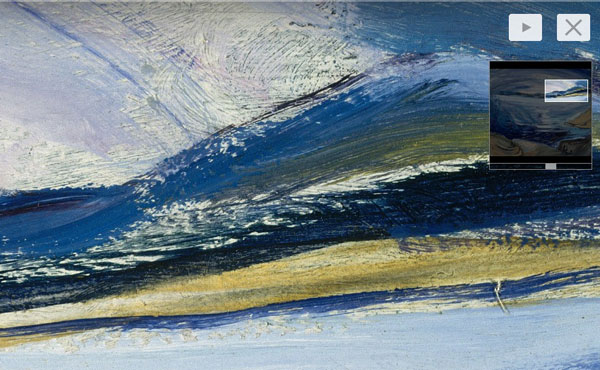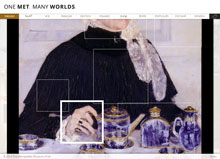Tags
Related Posts
Share This
Google Art Project: all looks and no brains?
For over two thousand years, museums have diligently worked to gather arrays of artwork, house them, explain their individual slices of history and display them. The museum’s walls, interior and exterior, create clear-cut spaces for us to wander. Museum walls were the gatekeepers of art: that is, until nearly 70 years ago, when André Malraux ushered the world into his musée imaginaire.
In 1947, Malraux—an art theorist, novelist and France’s first minister of culture—presented his “museum without walls,” an imaginary structure, not rooted in any one place, where works were not nailed to walls but rather released into the hands of people through photographic reproductions. For Malraux, reproducing art in books dissolved the restrictive walls of the institutions that housed the world’s cultural treasures.
Now, transport Malraux’s wall-less museum to 2011, when Google entered the imaginary museum and built on its bold addition, the Google Art Project. The addition has seemed to sparkle, being seen as the new way to educate about, and spread, the world’s wealth of art.
![One of the world’s leading art galleries, The Metropolitan Museum of Art needs little help from the Google Art Project to attract viewers to the gallery and its website. [Photo Copyright: Maciek Lulko]](http://www.cusjc.ca/capitalarts/wp-content/uploads/Met-Main-Hall.jpg)
The ship sails on. The Metropolitan Museum of Art needs little help from Google’s tiny online sample to attract visitors to its majestic Manhattan venue or to its own website.
[Photo © Maciek Lulko]
However, while Malraux in heaven, and others, on earth, may applaud another Google triumph, the question of how effective and necessary the project actually is for museums and viewers is slowly peeling paint off the canvas.
Rich returns were expected
For most museums and galleries, making their collections available to the broadest possible audience is part of their mandate. So, for institutions including the Textile Museum of Canada (TMC) and the Art Gallery of Ontario (AGO), teaming up with the Google Art Project seemed an obvious opportunity to further their mission—especially as many museums were already working toward digitizing their collections on their own at the time. It was a great opportunity to promote accessibility, said Roxane Shaughnessy, curator and collections manager at the Toronto-based TMC. According to Google, more than 19 million unique visitors accessed the platform between June 2013 and June 2014.When the Google project first launched, it was “really seductive,” says Jim Shedden, publication manager at the AGO, adding that the amount of press which zoomed in on it helped to make the project even more attractive.
The AGO joined the project in 2012, as the first Canadian museum (only another nine have partnered with Google since). A news release by the Canadian Heritage Information Network reported that “the added media interest contributed to a 25 per cent increase in visits to the AGO website the week of the launch.”
It is possible, however, for museums to generate millions of views to their sites without the Google Art Project’s help. The Metropolitan Museum of Art is one example, with 44 million visits to its website annually. Although the New York City–based institution is included on the Google site, Google’s selection of 80 works represents a surprisingly small portion of the Met’s digitized collection: over 400,000 works available on the museum website. Furthermore, the Met site is sophisticated and well built, featuring high-resolution viewing very similar to that on Google Art, along with numerous learning resources (see sidebar).

The Google Art Project entices viewers to examine brushstroke-level texture of paintings such as Emily Carr’s Seascape (1933), at the Royal BC Museum. [Photo courtesy of Google Art Project]
The Royal BC Museum, which has a collection of 81 pieces online showcasing the work of renowned Canadian landscape and modernist painter Emily Carr, hasn’t seen viewers pushed to their site through the project, said David Alexander, head of new archives and digital preservation. “What we wanted was more exposure for our collection but also more traffic to our website, for people to see the artwork and get excited and want to see more. What we’re not finding is increased traffic from Google Art Project to our website or our other digital projects.”
A piece missing?
It can’t be forgotten that accessibility to collections is only one part of what museums are attempting to achieve with new, online technology. Engaging the public in learning and understanding about art is an important part of any museum’s mission, and is a main expectation sought by the public.
‘I applaud what Google is doing, but it’s only one piece of what art education is about.’ – art historian Sara Angel
An abiding criticism of the Google Art Project is that it stints on textual commentary about the art, understating (or completely leaving out) the significance and context of each work. And while high-resolution brushstroke viewing promotes the close looking that museums encourage, unless you know what you’re looking for, it’s not necessarily helping art education. “It’s the difference between you walking through the Met and trying to figure it out yourself or being taken through by an educated guide,” says Sara Angel, Trudeau Doctoral Scholar in art history at the University of Toronto. “I applaud what Google is doing, but it’s only one piece of what art education is about.”
Last year, Angel established the Art Canada Institute because she believed there was a significant lack of information online about Canadian art: “The education piece in understanding art is critical.” Angel notes that what matters is having the image accompanied by credible and responsible commentary. “I think the piece that’s left out of Google Art Project, there isn’t that provision of material that then gets into the explanation of what the art is and what it’s about.”
![The Google Art Project allows for closer viewing of a painting than could ever be achieved in person, but is that its greatest strength? [Photo Copyright: Eric Parker]](http://www.cusjc.ca/capitalarts/wp-content/uploads/Looking.jpg)
Getting the whole picture. Online, Google allows closer viewing than could ever be achieved in person, but critics say it misses the informational overview.
[Photo © Eric Parker]
Although Google may have been the first one through the doors of Malraux’s “museum without walls” in our technology age, it no longer is the only one. As Shedden says of Google, “They were ahead of the game.” But now museums themselves are able to recreate and improve upon Google’s idea, with greater context and learning resources.
Praise and gratitude are still heard for Google’s cultural initiative. But, as Shedden says, it may “become more and more irrelevant.”






